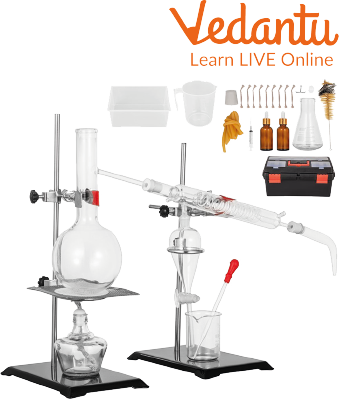




Glass Apparatus
Glassware apparatus are the different types of containers, such as flasks and funnels, which are used in laboratories in order to perform experiments. The glassware apparatus offers many functions such as the storage and transportation of the solution and other liquids. Most laboratory apparatus are made of borosilicate glass due to its durability and safety. This glass can bear high temperatures. Let’s read more about the types of glassware in the laboratory in the article. We will also discuss the purpose of glassware apparatus which are used in laboratories.

Glassware Apparatus
Why is Glass Used in Laboratory Equipment?
Generally, we use glass for making this equipment, the reasons for this are explained below. Firstly, glass is inert, meaning it will not actively react with the chemicals or substances placed inside the apparatus. It is also transparent, which allows us to monitor the solutions easily and also heat-resistant which allows us to heat the solutions in order to separate the components.
Since their inception, glass has been used by laboratories based on their specific experimental requirements. While ‘soda-lime’ glass can be used to make these, borosilicate glass expands less and is more adequate to use. Thus, it can tolerate rapid heat and cold conveniently. These properties of borosilicate glass make it fit for use and this is why this type of glass is widely used in making glassware apparatus.
Purpose of Using Glassware Apparatus
Laboratory equipment is used for holding liquids while working in a lab either in school or professionally. The main purpose of using laboratory equipment is to perform experiments safely. These equipment are also preferred so that measurements can be taken properly. The use of proper laboratory equipment is quite essential when conducting experiments for your safety and the safety of others. Laboratory glassware is crucial for virtually every type of chemical and biological analysis.
Types and Uses of Glassware Apparatus
There are many types of glassware apparatus used in labs; let’s discuss them in detail:
Beakers:
These are simple cylindrical containers, which have a size from 10 ml to 4000 ml. These are one of the most common glass equipment found in labs, they are used for holding chemicals, and for pouring liquids.
Flasks:
They are basically used to swirl contents without spilling. Stoppers are fitted to them. There are also two types: An Erlenmeyer flask has a flat bottom, so it is generally used for direct heating the components, whereas a Florence flask is the one that either has a round bottom or a flat bottom and can be used for direct heating as well with a heating mantle.
Test Tubes:
They are relatively smaller than the beakers. The test tubes are cylindrical in shape and are used to store the chemicals. They are also used to mix and heat the chemicals. They are very useful in observing what is happening to the chemical while conducting the experiment.
Watch Glass:
This glass container is generally used when the volume of liquid is very small, but a larger surface area is needed. It is good for crystallisation and evaporation processes and it can also be used as a beaker.
Graduated Cylinder:
It can be used when measuring the volume of liquid needed semi-precisely. It serves the purpose More accurately than a beaker or flask graduated cylinders.
Volumetric Glassware:
When there is a need to make high-precision solutions, you can use volumetric glassware to get precision of up to four significant figures. Volumetric flasks have an etched mark on their neck that shows the high precision volume at the specified temperature.
Pipettes:
These are also one of the measuring volumetric glassware which is used to dispense liquids. These are considered one of the most precise measuring glassware apparatuses. The solution present in them is drawn within the pipette. There are micropipettes present when you need to deal with very minute quantities ranging from 1 ml to 1,000 ml.
Burettes:
These are typically needed during titration experiments. They are round bottom flasks, separatory funnels, filter funnels and ceramic crucibles along with mortar and pestle are some of the other common glassware that might be used for some specific purposes in experiments. These types of common lab glassware make laboratory functions convenient and precise.
Summary
To conclude this article on glassware apparatus, we would say that glassware apparatus has made our lives easier in a real sense. They have made performing experiments in labs easier and more convenient. However, as conveniently they are used, one should be very careful while using them as a little carelessness can lead to severe problems like the chemicals can harm us or the mixing up of chemicals can lead to a tiny blast.
We have covered all important things of discussion about glassware apparatus in this article. We have discussed the glassware apparatus uses, types of glassware in the laboratory in the above article. We also looked at the glassware diagrams above.
FAQs on Uses of Glassware Apparatus
1. What are the uses of a funnel?
Some of the Uses of Funnel are as Follows:
Funnels are used to channel liquids or even fine-grained substances. They are also used for pouring liquids as they have a small opening and there are fewer chances that the liquids will spill on the floor.
2. What are the materials which the laboratory equipment can be made of?
Apart from the glass, these apparatuses can be made of certain metals such as stainless steel and aluminium and certain types of plastics such as polyethene and polypropylene.
3. Which chemical can damage the borosilicate glass?
Hydrofluoric acid is a chemical which can damage the borosilicate glass which is why it is often recommended not to clean the glass with hydrofluoric acid.









